#north west coastal content
Explore tagged Tumblr posts
Text

Lelt "Solomon Harris" of Kitwanga/Gitwangak Pastel by W. Langdon Kihn, 1924.
#I posted#Anika posts art#art#native content#british columbian content#british columbia#north west coastal content#canadian content
17 notes
·
View notes
Text
It's been a few years since I wrote much DCU fan content, but I have gone on refining things like geography headcanons sort of absently.
For my purposes Gotham is typically in Rhode Island, quite a bit further south than Providence, which in this universe is a much smaller city than in reality because Gotham was there between it and the sea.
Possibly on Conanicut Island; sometimes material writing Gotham as a double for New York leans upon Manhattan's island status in some way. Possibly on the mainland, if you don't have any use for that. Or both. Regardless the 17th century history of the Narragansett is implied to have sucked even harder than it did irl.
It seems to have gotten popular since the Teen Titans cartoon to put Gotham in Connecticut; I can work with this too. Maybe it replaces New London. Any further west and you're fully in Long Island Sound and too close to New York City.
The important features of Gotham are that it's coastal, it's around four hundred years old, and it was founded by English colonists. There have been a lot of variations ofc, including that period where Metropolis and Gotham were hilariously right across a bay from one another, but enough of the history-of-Gotham-and-the-Waynes segments over the years have leaned hard into distinctively New England elements that I cannot accept a Gotham that isn't north of New York.
Also for weather reasons even New Jersey seems like quite a stretch, and there's nowhere to jam a city in there without getting sucked into the orbit of existing stars in the metropolitan belt and ruining the vibe anyhow.
Metropolis meanwhile is, as far as I'm concerned, in Delaware, on the west coast of Delaware Bay, having been established in the 1920s as an ambitious planned futurist city and sucked up a lot of the development that would otherwise have gone to Philadelphia and Baltimore, and taken a bite out of the population of DC also.
Suicide Slum is where the people hired to build the city were living while doing so, a common side effect of such planned construction, and it ballooned in the 30s when the world economy crashed.
Metropolis was saved by WWII, when the feds sited a lot of war production and military transport out of its harbor because the place had been built on a grandiose scale that hadn’t ever hit peak utilization due to the Depression, so it was convenient. There’s still a large Army base near city limits; Lois spent her teens in base housing because her dad was stationed there.
#hoc est meum#dcu#geography and history headcanons#gotham city#metropolis#metropolis' name just screams planned city even before you get to the City of Tomorrow tagline#meta#fictional geography having to jam itself in around real geography
25 notes
·
View notes
Text
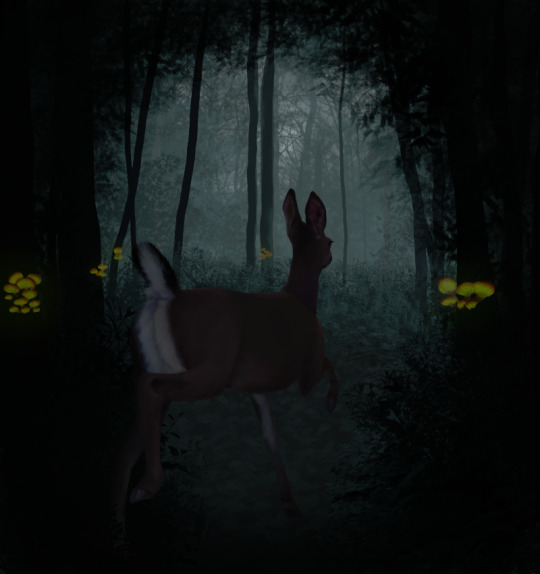
Deercember Day Twenty-Seven: Columbian Black-tailed Deer | Will-o'-wisp
The Columbian black-tailed deer or blacktail (Odocoileus hemionus columbianus) is found in western North America, from Northern California into the Pacific Northwest of the United States and coastal British Columbia in Canada. East of the Cascade and Sierra Nevada Ranges in Oregon and California, black-tailed deer are replaced by other mule deer which have a different tail pattern. They have sometimes been treated as a species, but virtually all recent authorities maintain they are subspecies of the mule deer (Odocoileus hemionus). Strictly speaking, the black-tailed deer group consists of two subspecies, as it also includes Odocoileus hemionus sitkensis (the Sitka deer). Despite this, the mtDNA of the white-tailed deer and mule deer are similar, but differ from that of the black-tailed deer. This may be the result of introgression, although hybrids between the mule deer and white-tailed deer are rare in the wild (apparently more common in West Texas), and the hybrid survival rate is low even in captivity. These two subspecies thrive on the edge of the forest, as the dark forest lacks the underbrush and grasslands the deer prefer as food, and completely open areas lack the hiding spots and cover they prefer for harsh weather. One of the plants that black-tailed deer browse is western poison oak, despite its irritant content. During the winter and early spring, they feed on Douglas fir, western red cedar, red huckleberry, salal, deer fern, and lichens growing on trees. Late spring to fall, they consume grasses, blackberries, apples, fireweed, pearly everlasting, forbs, salmonberry, salal, and maple. More information here.
References: Deer, Background, Mushrooms 1, Mushrooms 2.
#this went better than I ever could have hoped or expected and may be my new favourite#this one is special to me because this subspecies of mule deer is exactly the same#as lives on the property where Stan and I will be building our home#and is one of only a handful of deer who I've had the honour of seeing in person#the mushroom species is the western jack-o'-lantern mushroom (Omphalotus olivascens) native to California and Mexico#shoutout to my bestie Wind for the amazing suggestion for a natural will-o'-wisp#I am‚ quite frankly‚ blown away with myself today#Deercember#realHum#Art#Drawing#deer#deer art#Columbian black-tailed deer#Columbian blacktail deer#Columbian blacktail#black-tailed deer#blacktail deer#blacktail#Odocoileus hemionus columbianus
5 notes
·
View notes
Text
Holon Information Post
{ooc: this is gonna be a bunch of headcanons so I know the rules Phil’s playing by. Feel free to agree or disagree with whatever!)
When I first made this blog I made a poll on what people know about Holon so I could make a post explaining a bit about it as a region. Since then I’ve been making this to try explain parts of our region and what were known for. This will be long but if you’re interested I think it’s worth a read!! Though of course I’d say that!
Contents
Geography Culture δ / Delta Species Pokemon Pokemon ex & Holon
Geography
Holon is both the name of the region and the name of our main city pictured below. For ease, Holon will refer to the region, Holon City/HC will be the city.
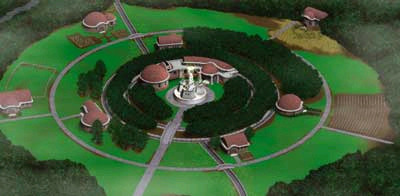
Thanks to our very small population and being a place of minimal interest, the region is mostly comprised of Mirage Forest. In the above photo, Mirage Forest is all the wooded bits around the edge. HC is quite small in comparison and completely surrounded by the Forest! This photo is a little old as there are more buildings in the open green spaces but we haven’t expanded the city’s limits. At the centre of the city there is the research tower that’ll be discussed more later.
Holon Lake is on the southern outskirts of Mirage Forest, just past some marshland. The other side of the lake leads to a lovely mountain range that is the most exhausting hike you’ll ever do, even if you use the caves for rest.
Holon is a coastal region! To the north-west of HC is the sea. The main island off the coast is Fract Isle, known as the ~mysterious island~ to most. Fract Isle’s most notable trait is that it grows ex crystals, again to be talked about later. Below is a picture taken on Fract Isle that includes a crystal cluster.
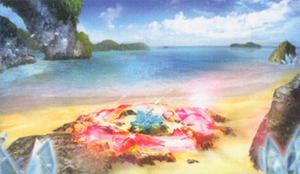
There is also a chain of small islands, the first of which is just about visible from Holon’s coast. There’s very little human presence on them or Fract Isle, just wildlife workers like myself and tourists.
Culture
I’ll be honest, it’s really hard to identify what should be here.
Since we’re a small region, it’s a close-knit community we’ve made. Everyone knows everyone to some degree, even if you never interact with them. This extends to people we know who don’t live here. I’ve talked about my interregional friends so much that when they come over most people accurately greet them and ask them something personal. They don’t come over that much after their first time.
Our relationship with Pokemon is a bit different too. We don’t have as big a “trainer culture” as most other regions. People keep Pokemon if they want to but there’s no obligation to from Holon, most of the pressure is from other regions. As a result we don’t have a Gym or League system, nor an Elite Four. We have one Pokemon Center that’s apparently a little bigger than ones in other regions. I guess this is to accommodate tourists who end up in battles with our Pokemon — they are likely underprepared. Those who do keep their own Pokemon are expected to be able to do most the care themselves. I invested in my own healer when I had to get a Service Pokemon. Very expensive. But that’s what’s expected if you can!
We do have 1 school building that has room for every child of different ages but it isn’t a trainer school — kids or parents who want that for their kids send them to other regions. This is also true of other specialist schools. At that point it’s expected they won’t come back to Holon for years if at all. I myself am an exception.
Another minor thing is a mix of self-sufficiency and collectivism. It’s a “you do what you can for yourself but if there’s anything you can’t do we won’t hesitate” thing. Pretty much every home has at least one berry crop of some kind, the healer thing, apricorn Pokeballs is a common practice; if you can’t do these there’s no shame! Everyone else will give you what you need and do what they can to help you get to the point you can be independent.
We’re getting more tourists than ever, likely due to the Internet allowing other regions to learn about us and our phenomena. I work with Renée and she’s apparently famous on some social site for posting clips and pictures of Sanctuary Pokemon. The issue is people come here wanting to take home a “weird Pokemon” and are grossly unprepared. Like one Ludicolo δ has wiped out a whole group that came wanting something. This has unfortunately put some strain on our Pokemon and how they view humans in general. Even the ones who go to the Shelter have to put a day in at the Sanctuary to be considered for adopting a δ Pokemon to prove they’re up to it.
Another reason may be that someone from Holon is one of the founders of the TCG. Helped us get some fame from there, although that influence has likely long dropped.
δ Pokemon
δ Pokemon, A.K.A. Delta Species Pokemon, are Pokemon whose DNA has been altered so it’s a different type. δ Pokemon are unique to Holon due to our weather; we have electromagnetic (EM from now on) storms fairly frequently. The region has natural EM storms, yet there has been an increase since the Research Tower’s construction as it emitted EM waves for its original purpose of finding Mew. EM waves are what cause the change to δ Pokemon, hence the influx of δs on the mainland despite consistent numbers on Fract Isle and the other islands.
Not all δ Pokemon are one from their hatching. The EM can affect them at “vulnerable stages” which is pretty much hatching & evolution. There are some cases of the change happening while at a healer so that may count but there’s not enough of a sample size to truly suggest the claim. There haven’t been any recorded cases of this but it’s theorised that phenomena such as Mega Evolution, Z-Energy, Giganti/Dynamaxing, and Terastilizing could also form “vulnerable stages” as Pokemon move into/out of them. Terastilizing especially!
( Small side note: Holon and Paldea have a few things in common: Pokemon changing type due to natural phenomena, phenomena-associated crystals, poison Woopers (δ Pokemon in our case), it being considered rude to enter people’s homes off the street, investment & use of door locks, and probably more I’d know if I ever visited Pa more. )
A lot of the time the change in type is addition of the Steel type or, in already dual-type Pokemon, one type being replaced by Steel. For examples, see my Orich (Psychic/Steel) and my friend’s Beedrill (Bug/Steel). Other type changes are possible even within species! I know a whole group of Electric Totodile-line δs that have a couple Grass ones in their ranks. It isn’t preset, so to speak, but it seems EM is more likely to change them to some types over others.
Explaining δs is hard to do without touching on how types work and whether they are real things. I can’t say much as I don’t know any science or sides of the debate, however I do think the traits we associate with the types aren’t just a random collective we group together for no reason. Orich’s got fur like copper, he’s immune to poisons & venoms, and he’s sensitive to heat physiologically. There’s likely a link between these traits all being activated by the EM. That’s just my thoughts though, best to listen to the professionals.
Pokemon ex & Holon
Pokemon ex (a shortening of “Pokemon Extra”) are found in many other regions, they are not a Holon exclusive. From memory they were first acknowledged in Hoenn. Pokemon ex are Pokemon with enhanced ability in all areas but most notably health and attack. They’re sought by competitive battlers as a result, even by those who don’t do Leagues because exs are more capable of different moves. There are whole separate battle systems where exs are legal and their move pools include home-brewed techniques. One of the more famous and recent examples I know of is a Paldean Ampharos ex who has a signature Thunderstrike Tail. However, Holon doesn’t have any part of these systems housed here.
From what I’ve looked up and asked professional researchers I work with, the true cause of Pokemon ex is unknown. The best guess Holon researchers have is ex crystals. Found in abundance on Fract Isle, residents of Holon and tourists alike have a habit of taking some home; our Pokemon Center sells faceted pieces, raw pieces and jewellery. This doesn’t explain exs’ presence in other regions. It’s possible it’s a different phenomenon entirely to what the crystals do and they’ve been incorrectly labelled the same.
And yes, there can be overlap between ex and δ!
Hope this was a good read and not too long! I tried to keep to the need-to-knows and stay off tangents.
#Orich the Espeon δ#He featured! He’s getting a tag!#rotomblr#pokeblr#pokeblog#pkmn irl#God this took ages. I can get back to normal posts now.
9 notes
·
View notes
Text
Beer and Clothing in the Occident
This post is a reference guide to the Occident, and a follow-up to a couple of previous actions. Much of it applies also to the colonies around the Pearl Sea.
It has been about 500 years since the founding of Azimuth and the beginning of the Sun-Divers as a race, from which events they number the years; the Prophetic Twins, 23 when the calendar was revealed, began it in Year -84. The 364-day solar year is perfectly harmonious with the 13 lunar months (28 days each).
Geography
The realms of civilisation in the Occident are:
The elevated but low-relief plateau of the West. Dominated by savanna, with tropical forests in river valleys and along the coast, and ruled by a crab-bucket of tribal oligarchies.
The relatively cool mountain highlands that run down the continent north/south. The mountains are covered in terrace-farms, the volcanic terrain being well-suited to wet rice cultivation. Cloud-forests, vertical archipelagoes.
The coastal hills of the east, dominated by city-states and little kingdoms. Cities tend to be built in the hills, with adjunct ports on the coast.
The seasonal northern peninsula and islands. Dry forests, more city-states.
The forested, swampy northeastern lowlands support support large (but disorganized) populations of Night-Singers, who generally live as swidden farmers or sedentary/semi-nomadic hunter-gatherers. They also practice shellfish aquaculture on bamboo frames.
The hills around the Red Lake and Azimuth, which mix traits of the highlands and plateau.

[Americas for scale and latitude.]
The climate of the Occident is not amenable to horses, though there are llamas in the mountains. In the plains, chariots are sometimes drawn by robust, omnivorous avians—mvao—which somewhat resemble secretary-birds.
Social Structure and Customs
The basic structuring unit of Sun-Diver society is the clan. The “Great Clans” are derived from the 364 pairings of the 728 [yes, this is a retcon] original Sun-Divers who descended from the Flowering Tree. (Not, of course, that everyone agrees on the names and identities of those individuals, or who is descended from whom, or whose clan-day is what. A number of competing systems exist.)
Little Clans, of which there are thousands, descend from the Great ones; they are exogamous (in some places, you must marry outside your Little Clan and within your Great Clan). Descent is generally patrilineal, with some regional variation. The human minority organizes itself along similar lines.
There is a simple four-part caste system, with noble clans, common clans, outsiders, and slaves. Outsiders, mostly night-singers, immigrants, and freedmen, do not share in the community of clans (though they can still attain high status), and slaves are alienated from it. Slavery is inflicted on prisoners of war, or as punishment for a crime or debt; legal details vary. It may be transmitted between reincarnations, but not to children. 20% of Sun-Divers belong to noble clans, and not all are de facto wealthy.
The relationship between oneself and one’s previous incarnations is not quite self-identity, but not quite parent-child.
Outside the Night-Singer heartland, the population ratio of Sun-Divers/Humans/Night-Singers is something like 70/15/15, with higher human populations in the north and the colonies (70/20/10 or similar).
Villages have headmen, typically elder (older and more-reincarnated) members of a locally-important noble clan.
Dwellings are long houses, normally raised and thatched, and arranged around a central crèche housing eggs and chrysalises. Bamboo is an important material in craft and building.
A terrible and notorious crime among them is to incise the chrysalis and drink the contents.
Clothing tends to be cotton, adorned by the nobles with dye and feathers. It also tends to be sparse, outside the high elevations. Long strings of glass beads or pearls are much prized.
Sun-Divers and Humans Classic in a given area speak mutually intelligible languages, despite the various alterations applied in Sun-Diver speech.
Warfare is a primarily male activity, though all members of a clan are armed and expected to fight to the death in defence of a crèche.
In this era, battle is conducted by masses of archers armed with bamboo longbows, bolstered by small corps of warriors armed as close fighters, along with elephants and mvao-chariots.
Food and Agriculture
Their staple foods are, necessarily, liquid, and thicker dishes are somewhat more difficult to consume (thickness, sugar, and alcohol content assume a place similar to capsaicin in their cuisine). As in all poor agrarian societies, consumption centers on fairly simple preparations of staple crops. The prototypical dish is a thin broth of grain or sugarcane, possibly with spices, salt, other minerals, or fermented material added before consumption. The other prototypical dish is beer.
They are lactose tolerant, and dairy products are extremely popular. They have a startling tolerance for sugar and alcohol, and fermentation features heavily. The aforementioned beer is common, as are sago wine and arrack. The diet is supplemented with certain minerals and mineral-rich plants (these being preferred to mud and dung, except in famine conditions). Meat is occasionally present, in the form of blood or via fermentation, broths, and purees, but plant proteins predominate. They have an inordinate fondness for tea.
Nectar and fruit juice are not plentiful enough to be staples, but their market gardens feature strains of flowers whose yield of nectar is several times better than can be found in the wild, and floriculture is much more prominent than in baseline human societies. Honey is also a popular delicacy, and the honeyguide revered.
Religion
Their literary centrepiece is The Course of the Sun, a semi-coherent corpus of texts revolving around the deeds and sayings of the Prophetic Twins, the events and conflicts of their progress to the west, didactic dialogues between gods and mortals, and various primeval and primordial human and divine conflicts.
Sky-gods with obvious commonalities and cognate names rule most of the continent’s religious systems. The Implacable Celebrants are the primary religious institution, loosely united by occasional regional gatherings, loyalty to Azimuth, and a shared self-understanding. Other major and minor gods are integrated into several coherent (and increasingly elaborate) cosmic schemas.
The peculiar lifecycle of the sun-divers generates religious innovations. Viz:
The Sky, bright-eyed, rainbow-haloed, the Changer of Days, is minister to the chrysalis and the soul-in-dissolution. He is depicted as male or epicene. His temples tend to be open to the sky. In their simplest form, they are round, walled courtyard-sanctuaries with some holy plant, idol, or other cult object bleaching in the sun; greater ones feature concentric ring-enclosures of richly-painted stone colonnades and gardens, each occulted from the last.
Thousand Wombs, Worm-Mother, patron of the vermiform, is interpreted as a protector of children. She is popular with midwives and in folk magic; furthermore, in the elaborated cosmic systems of the temple-schools, she embodies the "receptive principle", associated with children, fertility, and the retention of knowledge. She is invoked to sanctify oaths and marriages, but is always reticent to release her gifts.
And, should the eyes tire of colors, or the heart of glory, there are the obeisances of the Last God—appeased lest he look with too much jealousy on those souls whose sunward flight rescues them from his ultimate domain. Those soon to enter the chrysalis burn resins and sing hymns, and one day a year is set aside in Azimuth to avert his wrath: the public buildings sweat in garments of white linen, all work stops, the citizenry take cover in their homes, and the gaze of the Oracles from the Arboretum’s pinnacle bleaches every flower with the pallor of bone and chalk.
[Pretty much all the gods had cults in the original batch from out East, thought that was in the era of Velarie’s dormancy. These are just noted as salient Sun-Diver specific things.]
3 notes
·
View notes
Text
B.C Storm in Canada: Atmospheric River to Ease Sunday, but Rainfall Warnings Remain in Effect

B.C Storm in Canada: Atmospheric River to Ease Sunday, but Rainfall Warnings Remain in Effect An intense storm system affecting British Columbia's South Coast is expected to ease on Sunday, but rainfall warnings are still in effect for much of the region. The atmospheric river brought significant rain, wind, and flash flooding to the Lower Mainland on Saturday, with some municipalities reporting over 100 mm of rain. Rainfall Forecast Environment Canada predicts that around 15 to 25 millimeters of rain will fall in the Vancouver area on Sunday, with conditions tapering off by the evening. However, the BC River Forecast Center has issued a flood watch for the entire South Coast, with specific flood warnings in place for the Coquitlam River and parts of West Vancouver Island, including regions around Tofino, Bamfield, and Port Renfrew. Record-Breaking Rainfall Rainfall in the region has already set records, particularly on Thursday, with Langley potentially reaching an all-time 24-hour rainfall record. Vancouver International Airport (YVR) also reported significant amounts, contributing to the overall deluge across several municipalities. Impact of the Storm The North Shore faced overwhelming rain and floodwaters on Saturday as the atmospheric river continued to impact coastal B.C. In West Vancouver, rivers overflowed, flooding streets and prompting multiple road closures. Social media videos captured scenes from Deep Cove and other parts of North Vancouver showing submerged homes and businesses. Heather from Deep Cove Collective, a local store and ice cream shop, described the situation: “We started blocking it up with wood and shelves,” as the business experienced partial flooding. In Burnaby, vehicles, including at least one bus, were seen submerged in the Still Creek area. City officials noted that while the area is prone to flooding, the severity of this event was exceptional. Brian Carter, Burnaby's Director of Public Works, remarked, "It is probably the worst flooding we have seen in years." Flooding and Road Closures In Surrey, flooding caused closures on King George Highway and on 152nd Street between 72nd and 82nd Avenues, with some regions under nearly a foot of water. City engineers expressed hope that the water would recede, especially with low tides expected in the early morning to assist drainage back to the ocean. Yonatan Yohannes, Surrey's Director of Engineering Operations, described the flooding as a “one in 50-year event.” Rescue Operations Additionally, Coquitlam Search and Rescue crews were deployed to assist three hikers stranded off Burke Mountain. Teams rigged ropes to help ferry the hikers across a creek that had transformed into a fast-flowing river due to the heavy rainfall. As the storm subsides, residents are urged to remain vigilant as recovery efforts continue and to stay updated on local conditions and warnings. Thank you for taking the time to read this article! Your thoughts and feedback are incredibly valuable to me. What do you think about the topics discussed? Please share your insights in the comments section below, as your input helps me create even better content. If you enjoyed this post and want to stay updated with more informative and engaging articles, don’t forget to hit the subscribe button! I’m committed to bringing you the latest insights and trends, so stay tuned for upcoming posts. Wishing you a wonderful day ahead, and I look forward to connecting with you in the comments! Keywords: B.C. storm updates, atmospheric river impact, rainfall forecast, flood warnings British Columbia, canada Read the full article
0 notes
Text
Krylandia [Rewritten]
Library of Circlaria
Blog Posts
The content of this entry remains largely unaltered from the previous version; although some minor changes have been made.
Hobland:
Straddling the North Pole, the landmass of Hobland consists of three regions: East Hobland, West Hobland, and the Arctic Steppes. East Hobland has towering mountain ranges in its North and plains in its South, and is known for its short summers and cold winters. West Hobland has two sets of lesser mountain ranges that run North-to-South between which lies a long, narrow plain, while a set of lower coastal plains lies near its Southern tip. The Arctic Steppes region consists of high plateaus and glaciers, and is cold year-round.
Over the past three centuries, East Hobland was dominated by three nations: Noliespe, Notulfa, and the Acrean Republic. Noliespe, the Northernmost country, was a loosely-organized federation of counties. Notulfa, bordering Noliespe to the South, was home to the Reltuvian and House Esary, and had a government structure similar to that of the nation of Monassa. And the Acrean Republic, the Southernmost nation, was a Kingdom until 1273 but has since boasted itself as one of the world's most progressive democratic societies.
West Hobland was dominated by the Rinean Kingdom in the North, the Humerian Kingdom in its central region, and Agridbea in the South.
Auriellia Skapavia:
Born in 1385 in the Notulfan city of Givenna, Auriellia Skapavia demonstrated talent, from the age of six, in spellfire-crafting. She began university training at age nine and became an Apprentice Spellcrafter at age eleven. In June 1398, at age thirteen, Skapavia received an official Authorization Statement from Cenofan to become the youngest-ever Master Stonecrafter in history. To note, there was no age limit requirement in the nation of Notulfa to receive spellcrafter training and certification.
Political Reform:
Gennos Fortek, then-Government Consul of Notulfa, congratulated Skapavia and her family on the accomplishment and scheduled a formal ceremony of celebration to take place in the Market District of the city of Notulfa proper, restricting public access in the process. Working-class inhabitants demonstrated contempt over this, however, as it caused major disruptions to daily schedules and flaunted the higher social class' inherited status of privilege. In September 1398, after numerous demands were ignored, the workers began carrying out protests, which led city government officials to place curfew orders. This only aggravated the protestors, and very soon, the protests grew nationwide, giving birth to a Movement of Solidarity identified by a coat of arms featuring a three-pointed star against a red background. The Solidarity Movement expanded beyond Notulfan borders to other Hoblandish nations, prompting Hoblandish leaders to call a Conference in the city of Boken, located along the South Coast in the Arctic Steppes region.
In January 1399, the Conference took place, where a decision was made to call an official Convention to take place in the city of Boken four months later in order to create a new power structure to satisfy popular demand. Leaders of the Solidarity Movement were invited along with representatives of Remikran nations. Then-Prime-Minister of the Independent Commonwealth State of Retun, James Lawrence Kontacet III, sent Ambassador Martin Georges to attend. By the end of May, the Convention formed a compromise by which the nations of Hobland would continue to exist with regard to their power structures, but would each send elected representatives to a Council in Boken, which consisted of two houses: the Assembly of Consuls and the Chamber of Representatives. This would form the democratic government a new nation: the nation of Krylandia. This new nation would all Hoblandish nations and would become officially established on 2 January 1400. Such a government would also consist of a Judicial Branch, as well as an Executive Branch, the latter of which would be led by three Head Consuls: the Consul of Government, the Consul of Trade, and the Consul of Defense. Every member of every Branch of this newly-formed government would be directly elected.
The leaders of Agridbea initially resisted the effort, as the nation's Five Houses wanted the territory to remain independent. However, after long negotiations and compromises, all Five Houses agreed to have Agridbea join Krylandia on 11 January 1400.
0 notes
Text
Snatched it from @ multifacet-ed
Name: Lauren Location: coastal North Carolina, USA Star sign: Sagittarius Height: 5′8
Put your music player on shuffle. What are the first 6 songs that popped up?
Unholy (Sam Smith) 【covered by Anna ft. @chloebreez】| dual POV ver.
Mama Said by Metallica
Mary on A Cross (You go down just like Holy Mary) by Ghost | Cover by Justine M.
Wicked Ones by Dorothy
The Sound of Silence by Disturbed
Reasons I Drink by Alanis Morissette
In a relationship?
I’m as single as they come. And that’s not going to change anytime soon.
Grab one book nearest to you and turn to page 94. What does the first paragraph say?
Lucia's brows furrowed, her fists clenched as she stayed herself, wishing Alessandra would reach for her, give her an excuse to catch her up in her arms, and take her to bed, but the pirate was still as a statue. She wondered where the captain's previous bravado had gone—where her own had gone. Where are the teasing words, smirking lips, and inviting touch? -- Pirate's Queen by Riley West
Ever had a poem or a song written about you? Not to my knowledge.
Who is your celebrity crush?
I don't think I really have one. Although, I have been pretty interested in Mary Kate Morrissey as of late.
What’s a sound you hate; sound you love?
Hate: Nails on a chalkboard or similar high pitched scraping / scratching sounds. I'm also not a fan of the screaming / crying / high pitched squealing noises made by babies and toddlers. Or just loud children in general. Love: Good music.
Do you believe in God / a higher power?
I'm an atheist, so no. I don't believe in any of it. And even if there is a God, I don't care. I don't care about "Him" or religion. As a matter of fact, I'd be happy if I never had to hear about any of it ever again.
Have you ever crashed a car? Only in a recurring dream (nightmare?) that I've been having since I was in high school. Don't ask me why.
What was the last book you read?
The Spanish Pearl by Catherine Friend. It's a sapphic tale about an American lesbian named Kate Vincent who travels to Spain with her partner, Anna, to adopt a five year old boy named Arturo. Unfortunately, during the trip Kate decides to take a tour through a cave and actually ends up traveling back in time to the year 1085. While she's there she's captured by a band of mercenary soldiers and becomes an unwitting pawn in the violent conflict between the Catholic kings and the Islamic Moors. In her struggle to stay alive, she must flee exotic harems, filthy dungeons, and treacherous Moorish courts. Along the way she meets a sword-brandishing champion with an astonishing secret, and the next thing she knows she's torn between two women and two centuries. If you're into sapphic stories, time travel, and adventure with a little history thrown in then this may be the book for you.
What is the current show that you're watching?
UnREAL. It's an American drama series about a woman named Rachel who is a reality TV producer pushed by her unscrupulous boss, Quinn, to swallow her integrity and do anything it takes to drum up salacious content for their dating reality show Everlasting.
Last movie you watched?
NYAD. It's the remarkable true story of athlete Diana Nyad who, at the age of 60 and with the help of her best friend and coach, Bonnie Stoll, commits to achieving her life-long dream: a 110-mile open ocean swim from Cuba to Florida. What’s the worst injury you’ve ever had?
When I was nine years old I got hit between the legs with an old, jagged, splintered wooden plank that my brother and I were using as a see-saw. I ended up with some cuts (thankfully they weren’t that deep) and scratches on both of my inner thighs as well as my vagina. And if that wasn’t bad enough, one of the jagged pieces actually broke off and somehow managed to lodge itself in the most upper part of my inner thigh. I now have a scar there because of it. Needless to say, it hurt like hell and I’m not even exaggerating when I say that it was several days before I was able to go to the bathroom without wanting to cry.
Do you have any obsessions right now? I suppose I have been a bit obsessed with Wicked (mostly the musical) lately.
Do you tend to hold grudges against people who have done you wrong? I usually don't or at least I try not to. However, I think it would depend on the severity of the situation and who the person is. If it's something fairly minor, then I can usually look past it and not let it get to me. But if it's something more serious, something that really hurts or upsets me (especially if it's done by someone close to me), then there's definitely going to be some resentment for it. At least for a while.
0 notes
Text
Although land crabs regularly appear in the exotic pet trade, there is not much care information around for these species, excepting the most widely traded of the land hermit crabs, Coenobita clypeatus. For a while much confusion surrounded the rainbow crab of West Africa, Cardisoma armatum, and the moon crabs of the grnus Gecarcinus, which are imported from the opposite side of the Atlantic. I had myself thought the moon crabs, traded at a smaller size than the rainbow crabs, were a growth stage of that species. The similarities were not merely superficial, because both genera are members of Gecarcinidae, a major clade of land dwelling crabs. At least two species of Gecarcinus were turning up, these being G. lateralis and G. quadratus.
A well studied species, G. lateralis might be thought of as the ordinary moon crab, and most of my scientific information pertains from descriptions of this species, which is also called the Bermuda land crab and the black-back land crab, as well as some other names. Whatever it is being called, G. lateralis is present in coastal environments, where it lives above the tide mark, including where there is no standing water. Reportedly G. lateralis can grow to attain a carapace as long as 10 to even 12 centimeters, or 4 to almost 5 inches, and a legspan that is 15 centimeters or 6 inches. If such specimens exist then they are rare. A study of the burrowing behavior of this species in forest habitat, did not indicate any of such large crabs, their carapaces measuring closer to 5 centimeters or 2 inches when mature. However in a related species, G. ruricola, large males and slightly smaller females are demonstrated to possess carapaces about 9 centimeters wide, whilst 5 or 6 centimeters would be a more common carapace width.
The related species G. quadratus also has many names, but the Halloween (moon or land) crab is by far the most widely encountered, at least in the exotic pet trade. It may also be encountered with the labelling of harlequin land crab, among others. These two names do not seem to be in use when referring to any other Gecarcinus species, all of which may for example be referred to as red land crabs or moon crabs - labels shared with land crabs from other gecarcinid genera. G. quadratus is a native of the coastal rainforests of Mexico and the Panamanian land bridge, that attaches North to South America. This species has a carapace length of about 5 centimeters or 2 inches. I do not have a clue as to how variable in size this species of Gecarcinus is. Although it is clear that mature members of species in Gecarcinus, may show size variation.
Although Gecarcinus sp. larvae are dependent upon saltwater for their survival, the adult crabs have no such requirement. Although they might be found on beaches and in estuarine environments, adult G. lateralis died at salinities of 30 and 35 ppt, whereas they flourished in freshwater, and at lower salinities of 15 and 20 ppt. I do not have information about the salinity tolerance of G. quadratus, but adults belonging to both species do perfectly fine with access only to fresh water. These crabs are obligate air breathers and no not, in fact, require an aquaterrarium, provided their substrate is damp, or they have access to shallow water in a bowl or dish. This is because these crabs take up water using their abdomens. G. lateralis is also known to ingest damp sand for its moisture content.
Both G. lateralis and G. quadratus are present in environments where the substrate allows for burrowing behavior, and there is plenty leaf litter. Conspecific crabs are present in vast numbers, might share an environment, and this might be thought apt for these species the aquaterrarium, considering their herding habits in the wild. Nonetheless, each of these crabs will need space to avoid the behavioral incidents arising from overstocking. Cohabiting crabs would also need a complex environment, which they can use to avoid confrontations among their kind when necessary, not least if they are molting, because the presence of conspecifics reduces the survival of molting crabs. These crabs molt inside their own burrows for protection during this vulnerable, temporary time. Although this genus has strong herbivorous leanings, the older crabs are known to kill their juvenile conspecifics for food, especially when they are under nutrient stress
Gecarcinus are classed among the herbivorous crabs, and they do possess the abilities to digest cellulose, and consume fibrous plant materials. However their herbivory is not total, and foods of animal origins are accepted. Their diets are 80% vegetarian whereas it is only 10% of arthropod origins, and they can consume both green and brown (dead) plant matter. Although they prefer to eat fresh plant material, the wild crabs might consume more leaf litter. G. lateralis is a significant consumer of seeds, fruits, and propagules, avoiding vegetable foods with strong alkaloid defences. There is reason to believe genus Gecarcinus consume a broader spectrum of foods in the dry season, including fruits and carrion. Cannibalism in these crabs increases when access to nitrogen is decreased.
Gecarcinus sp. are burrowing crabs, and they use their burrows to shelter in less hospitable seasons, plugging their burrow and storing leaves as their food supply, when the temperature drops and the air humidity decreases. This behavior assists them avoiding water loss in the dry season. For this reason the air temperatures in the vivarium housing Gecarcinus sp. should not drop as low as 15-18 degrees centigrade, unless one wishes to stimulate such behaviors, by simulating a Caribbean dry season. The crabs seem to use decreasing air temperature as their cue for this behavior, but are triggered to resume behavioral normalcy by increased rains and the return of higher air humidity.
These crabs in the vivarium require a dump substrate and a high air humidity of over 80%, based on the humidity inside crab burrows. The diurnal air temperature range, on a similar basis, should be closer to 28 degrees than to 20 degrees centigrade. People report success when keeping this species at 26 or 27 degrees by day. I have read that this temperature must not be allowed to fluctuate, but in the wild the air temperature in their habitats does drop a little by night, and Gecarcinus are night as well as day active foragers. If the environment makes them unhappy they will retreat into the microhabitats of their burrows. Although not necessary, these air breathing land crabs are easily accommodated in a paludarium, with a large land portion simulating a tropical forest floor.
The water portion of an aquaterrarium assists in maintaining a high air humidity, but these crabs do need to safely leave the water should they walk or fall in. For this reason any water area should be of a shallow depth, and the substrate ought to slope out of the water. As with all humid vivaria, it is also important that there is sufficient ventilation. Although the air should have a high moisture content, it does not follow that it be stagnant. I have not heard reports of Gecarcinus sp. being mixed with other species of land or water animals. However, gecarcinid crabs are strongly inclined to eat live plants, and destroy planted landscapes.
Gecarcinus are primarily feeders on edible fruits and vegetables, that will also accept proprietary defrosted and dry foods intended for aquarium fishes. Although they are predominantly vegetarians, Gecarcinus diets in the aquaterrarium should also include some animal proteins, to reflect their natural consumption of arthropod material, but they will also consume soybean based foods that offer a similar boost of nutrients. The opportunistic consumption of animal matter is a well known phenomenon in terrestrial crabs with herbivorous specializations.
#moon crabs#aquaterrarium pets#amphibious crabs#land crabs#genus gecarcinus#Gecarcinus lateralis#Gecarcinus quadratus#Bermuda land crab#red land crab#black-back land crab#halloween land crab#harlequin land crab#herbivorous crabs
0 notes
Text
Ahr: Pinot from Sun and Slate
Hectares under vine: 524 (2023) Climate: Mediterranean-like Soils: Devonian slate, greywacke, loam, loess Varieties: Spätburgunder (65.3%), Riesling (8.2%), Frühburgunder (6.1%), Regent, Weißburgunder, Portugieser, Müller-Thurgau Beriech: Walporzheim-Ahrtal Einzellagen: 43, including Ahrweiler Rosenthal, Altenahr Eck, Dernau Pfarrwingert, Heimersheim Landkrone, Neuenahr Sonnenberg, Walporzheim Gärkammer (monopollage of JJ Adeneuer), Walporzheim Kräuterberg
As we've seen in Zellertal in the northern Pfalz or Santa Ynez in coastal California, wine valleys with west-east orientations often yield something unique regarding climate. Its orientation is just one factor that makes the Ahr Valley, which sits above the 50th parallel north, distinctive. The Ahr River, a tributary of the Rhine, begins in Blankenheim in the Eifel region, "in the cellar of a timber-frame house near the castle" and flows for 25 kilometers through the Ahrtal (Ahr Valley) winegrowing region, and eventually joins the Rhine after Heimersheim. This side valley of the Rhine features steep south-facing slopes sheltered by the low Eifel range and benefits from the moderating influence of the Gulf Stream, creating a longer growing season than its next-door neighbor, the Mosel.
The Ahr's geography and climate help explain why it's a red wine-dominated region, with over 65% of its area planted with Spätburgunder and smaller plantings of the red varieties Dornfelder, Portugieser and, of local importance, Frühburgunder. Like the Mosel, the Ahr has a cool climate, and Devonian slate plays a pivotal role here, too, heating the ground during the day and giving warmth back to the vine at night. Slate and Pinot Noir is a rare combination, giving Ahr Spätburgunder a smoky and uniquely mineral identity, drawing international attention to its top producers beginning in the mid-1980s.
Until the late 1970s, Ahr vineyards comprised almost equal proportions of red and white varieties, and the local version of Weissherbst known as Ahrbleichert (from bleichen meaning to bleach) would have been standard in the Straußwirtschaften alongside unserious sweet red wines. Pinot Noir often came from lesser clones like Mariafelder and Ritter, and the region might have gone along contently mediocre if Werner Näkel, a former school teacher, hadn't been so enamored by Henri Jayer and the red wines of Burgundy. Näkel planted Pinot clones from Burgundy and used small oak barrels to produce a new Ahr Pinot type with class and sophistication like a great Vosne or Gevrey.
I still remember the buzz about Meyer-Näkel's 2005 Pfarrwingert Spätburgunder winning Decanter's Pinot Noir Trophy when many in the US trade were still unsure about Germany's potential as a world-class red wine producer. Meyer-Näkel, Jean Stodden, JJ Adeneuer, Deutzerhof, Nelles, Burggarten, HJ Kreuzberg, Sermann, and the Winzergenossenschaft Mayschoß* lead the Ahr on the quality front today. With the villages of Walporzheim and Marienthal at the center of the Ahr Valley, vineyards to its west are high, steep, and terraced featuring slate soils and giving wines with structure and mineral taste. East of Walprzheim, vineyards are lower and less steep, with loess and loam, and, in theory, show softer, more fruit-driven Pinots.
The Ahr vineyards to know are well-elaborated by the producers mentioned above. From east to west are Heimersheim Landskrone with greywacke, loam, and loess. Neuenahr Sonnenberg with greywacke, slate with loam and loess. Ahrweiler Rosenthal with greywacke soil, giving full-bodied and long-lived Pinots. Walporzheim Kräuterberg with slate soils. Walporzheim Gärkammer, greywacke and slate, a monopollage of JJ Adeneuer. The previously mentioned Dernau Pfarrwingert, a warm site of greywacke, produces ripe and aromatic Spätburgunder. The steep Altenahr Eck greywacke and slate yielding mineral-intense Pinot Noir and Riesling.
*Winzergenossenschaft Mayschoß (Germany's first cooperative winery was founded in 1868, before Germany became a nation!)
0 notes
Text
About Beaufort Sea, facts and maps
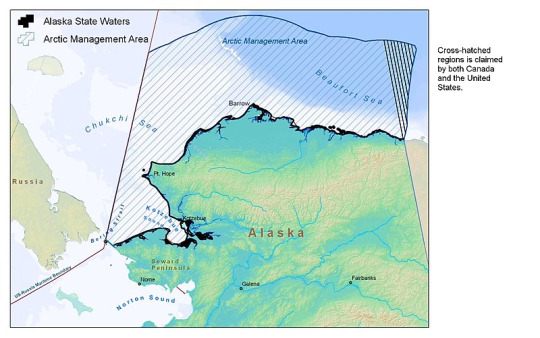
Beaufort Sea, outlying sea of the Arctic Ocean situated north of Canada and Alaska. It extends northeastward from Point Barrow, Alaska, toward Lands End on Prince Patrick Island, and westward from Banks Island to the Chukchi Sea. Its surface area is about 184,000 sq mi (476,000 sq km).. The Beaufort Sea is home to migratory birds, bowhead whales, other marine mammals. The Beaufort Sea, part of the Arctic Ocean off Alaska's northern coast east of Point Barrow, is a rich marine environment that supports many migratory shorebirds, seabirds, and marine mammals. What country is the Beaufort Sea in? Canada. The Mackenzie River, the longest in Canada, empties into the Canadian part of the Beaufort Sea west of Tuktoyaktuk, which is one of the few permanent settlements on the sea's shores. The entire surface of Beaufort Sea is completely frozen during much of the year, and permanent ice-pack covers the northern edge of the Beaufort Sea year-round.

Who owns Beaufort Sea?

As two of the five littoral Arctic states, both Canada and the U.S. may legally lay claim to portions of the Arctic Ocean, including control over shipping access and natural resource extraction in the Beaufort Sea. What lives in the Beaufort Sea? Five species of marine mammals occur regularly in the Beaufort Sea: the bowhead whale, beluga whale, ringed seal, bearded seal, and polar bear. The recurrent polynya and ice-‐edge habitat make the Cape Bathurst Polynya an important beluga, bowhead whale, polar bear, and ringed seal feeding ground. Why is it called Beaufort? Beaufort was later named for Henry Somerset, Duke of Beaufort. Originally a fishing village and port of safety dating from the late 1600s, Beaufort has been visited by patriots, privateers, merchants, and skilled craftsmen who built Bahamian and West Indian-style homes and public buildings. What 2 countries does the Beaufort Sea border? IN CANADA AND THE UNITED STATES Canada and the United States are involved in a long-standing dispute concerning the maritime boundary of the Beaufort Sea, located north of Canada and the State of Alaska. Can you drive to the Beaufort Sea? For almost its entire existence, it has only been accessible by boat or airplane, or an ice road in the winter—but in 2017 an 187 km all-weather road was completed connecting it to Inuvik and the Dempster Highway. How deep is Beaufort Sea? 4,683 m Beaufort Sea / Max depth Is the Beaufort Sea freshwater?

The Beaufort Sea, which is the largest Arctic Ocean freshwater reservoir, has increased its freshwater content by 40% over the past two decades. How and where this water will flow into the Atlantic Ocean is important for local and global ocean conditions.

Is there oil in the Beaufort Sea? The Beaufort Sea, on Yukon's north coast, has immense oil and gas resources. It's estimated there are: 67 trillion cubic feet of natural gas; and. 7 billion barrels of oil. How much oil is in the Beaufort Sea? Beaufort Sea discoveries are estimated to have 178.0 billion m³ (6.2 Tcf) of natural gas, 106.1 million m³ (667.4 million barrels) of crude oil and 0.2 million m³ (1.2 million barrels) of NGLs. Are there oil rigs in the Beaufort Sea? Canada's Beaufort Sea contains major gas and petroleum reserves beneath the seabed, a continuation of proven reserves in the nearby Mackenzie River. Offshore drilling began in 1972 carried out by companies as Panarctic Oils Ltd., Petro Canada and Dome Petroleum and 176 wells were drilled.
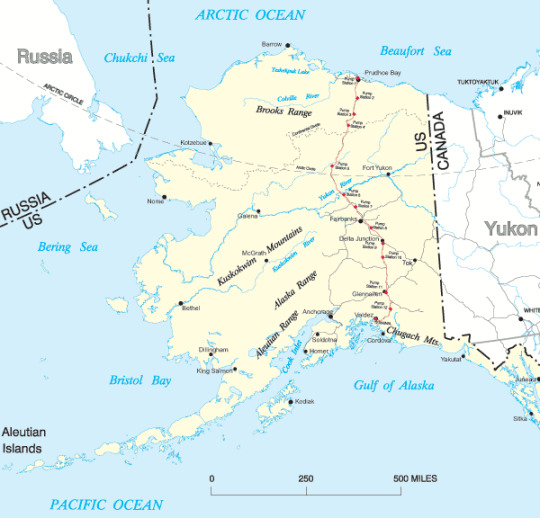
Is Beaufort A sea Island? Beaufort is located on Port Royal Island, one of the largest Sea Islands along the southeast Atlantic coast of the United States. How long is Beaufort Sea? The Beaufort Sea Coast of northern Alaska extends from Pt. Barrow eastward to the Canadian border, a straight-line distance of 610 km, and has 1,957 km of mainland coast. Are there alligators in Beaufort?
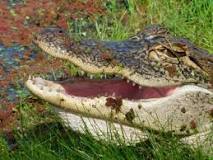
American alligators can be found throughout South Carolina's coastal plain, and they certainly love Beaufort County's natural spaces and mild winters. Can you swim in Lake Beaufort? Cool off during the summer months and explore Beaufort Lake. Located just 30 minutes from Ballarat, in the township of Beaufort, this man made lake is great for fishing, water skiing, canoeing and swimming. Pack a picnic and make the most of the great picnic and barbecue facilities. Why is Beaufort called Lowcountry? The Lowcountry derives its name from its low-lying topography. Located at the southernmost tip of the state, a large part of the Lowcountry sits at or below sea level. Is Beaufort a military town? The city is also known for its military establishments, being located in close proximity to Parris Island and a U.S. Naval Hospital, in addition to being home of the Marine Corps Air Station Beaufort. Beaufort is a romantic and popular tourist destination known for its history. Welcome to Beaufort, South Carolina! Read the full article
#AretherealligatorsinBeaufort?#ArethereoilrigsintheBeaufortSea?#CanyoudrivetotheBeaufortSea?#CanyouswiminLakeBeaufort?#CanyouswimintheBeaufortSea?#DoestheBeaufortSeagettsunamis?#HowbigistheBeaufortSea?#HowdeepisBeaufortSea?#HowdeepistheBeaufortSea?#HowlongisBeaufortSea?#HowmuchoilisintheBeaufortSea?#IsBeaufortamilitarytown?#IsBeaufortAseaIsland?#IsBeaufortSeainCanada?#IsitBeaufortSea?#IstheBeaufortSeaalwaysfrozen?#IstheBeaufortSeacold?#IstheBeaufortSeafreshwater?#IstheBeaufortSeawarm?#IsthereoilintheBeaufortSea?#What2countriesdoestheBeaufortSeaborder?#WhatcountriesdoestheBeaufortSeaTouch?#WhatcountryistheBeaufortSeain?#WhatdoesBeaufortmeaninFrench?#WhatishappeningintheBeaufortSea?#WhatisspecialaboutBeaufortSea?#WhatisspecialabouttheBeaufortSea?#WhatistheBeaufortSeacalled?#WhatistheBeaufortSeaknownfor?#WhatisthedifferencebetweenBeaufortandBeaufort?
0 notes
Text
TOC, Journal of Historical Linguistics Vol. 12, No. 3 (2022)
ICYMI: 2022. iii, 185 pp. Table of Contents Editorial Editor’s Corner pp. 335–336 Articles: There sentences in extreme southern Italy: On the rise of a “Greek-style” pattern Alessandro De Angelis and Giulia Bucci pp. 337–380 Erratic velars in West-Coastal Bantu: Explaining irregular sound change in Central Africa Sara Pacchiarotti and Koen Bostoen pp. 381–445 The change in the grammatical category of the copula in North-Eastern Neo-Aramaic Geoffrey Khan pp. 446–475 Diachronic developments in fr http://dlvr.it/ShbgkG
0 notes
Text
Plans and Diversions
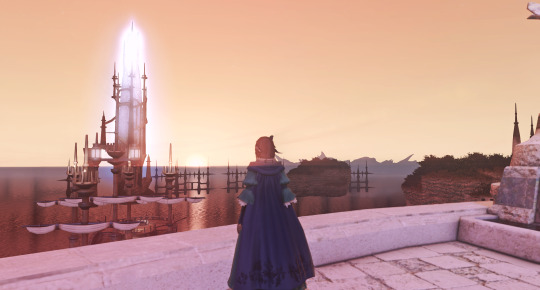
“Thank you so much!”
Nabi bowed deeply in thanks as she received the small linen pouch from the miqo’te merchant. Her buoyant yet formal demeanor garnered an amused look and a nod from L’zuhjha, the latter just tipping her red beret in return. It was the usual expression Nabi encountered when she offered the bow that was customary in Kugane; she had been told more than once that such formal gestures were not needed in the west.
It was a hard habit to break, and… Well, she was forced to admit there remained more than a little nostalgia in that she still wanted to carry parts of her home with her wherever she traveled.
There was a restlessness about her through the last few bells, as her mind darted back and forth over too many questions without any answers. Nabi found herself meandering about through Limsa Lominsa, eventually coming to a stop where she had a full view of a lighthouse in the distance. She stared at it, almost longingly, for a long time before looking down and regarding the parcel in her hand. She pried it open, letting the contents spill out onto her palm. Three small pearls glimmered with a reddish-gold hue, reflecting the final rays of a setting sun that also set afire her view of the sea beyond.
And as all things did of late, it reminded her of Anchor.
It had been only a few suns since he left for Upper Noscea and yet every night, the vacant space next to her felt all the bigger, the nights felt colder, even in this humid coastal weather.
I am being childish, Nabi chided herself with a shake of her head. They’d even spoken over the pearl the night before. He reassured her of the mission he would carry out with Shael in the lighthouse near Aleport, with hopes of joining them within a sun after. And yet, as she kept his pearl close to her heart all sun, there was no word from him about his return. Nabi felt selfish in wishing for some kind of an update, when Anchor and Shael needed to be focusing rather on their own safety and success.
As I should be. It was a sober reminder to herself, for what awaited on the morrow. As excited as both she and Ghoa were about being invited back to the Nylor mansion, once they met both the Doctor and his sister, Estrid, it became clear that things would be more difficult and complicated than they had planned.
‘I trust some of the residents' eccentricities are now clear.’
Mister North had subtly insinuated before the visit that the Doctor was dedicated to his mysterious agenda, and that his focus was solely about his sister’s well-being. What he left out was that the Doctor, while polite and intelligent, seemed singularly obsessed with his research, throwing all caution and possibly even welfare of other people to the wind.
Without hesitation—even while all were all right there, listening—he assumed loudly that he would put Nabi to the test, to make sure that she was safe in Estrid’s presence. Nabi understood why he might be alarmed with the immediate affect his sister seemed to feel in her proximity. Doctor Nylor did not give Nabi an opportunity to explain that she has had prior experience with the very specific ailment that Estrid was suffering under.
She recognized the bright amber crystal that was glimpsed beneath Estrid’s hood, one that had completely replaced her left eye and was growing jaggedly outward. It was the same crystal she had plucked from Anchor’s arm, when they had removed the gauntlet that Elam Grave had forcibly placed there. Nabi was certain that Estrid suffered from the same corruption that Anchor did. Only, hers seemed far more advanced, in that it was visibly growing out of her, and also affecting her mental state.
Nabi had her own theory—the fact that her magic and aether were having some influence over Anchor’s corruption was now expanding to include anyone that had the same taint to their aether.
Did this mean that Estrid and Anchor’s path might have crossed at some point in the past? None of the corrupted crystals in Limsa were of the same element as Anchor’s; all the ones they had studied here were those that had exploded upon Eorzea upon Dalamud’s fall. Their respective energies were distinctly different.
Nabi felt her heart race faster at the thought. This was a breakthrough. Someone else that had the same sickness that Anchor suffered from, and had a sibling that was researching solutions to the problem! Surely, if the Doctor and she could put their minds together—along with Ghoa, who was far more trained in aetherochemistry—Nabi was certain they could achieve more breakthroughs.
‘But whatever it is you hope to gain from this family, I hope it is worth these diversions.’ Mister North’s warning came to mind again. ‘Doctor Nylor's words to me have hinted that his scientific efforts have not been altogether painless on his part or his subjects.’
The possibility of her being hurt scared her, without a doubt, but she could not let it stop her. Nabi placed her hand flat upon her abdomen to calm the fluttering there. She knew that science and medicine sometimes involved pain. If it took tests to reassure this Doctor that she was no danger to his sister, and that they were more likely to find answers together than alone, then enduring some procedures was certainly worth it.
“What be the plan then? If somethin’ were tae go wrong. You have your way out? Has ya been mindful of their numbers? How many he’s got in service? Blaggards high on their coin are trouble, yara’æ. Ya still hasn’t made clear how exactly ya see this goin’ from dancin’ an’ singin’ tae talkin’ ‘bout corrupted crystals and–oh, I dunno, how he’s fuckin’ with that Funk fellow with his supposed treatments!”
Anchor’s words from their last correspondence suddenly roared forth from her memory, that Nabi winced visibly. She inhaled deeply, to let the briny coastal air cleanse her thoughts, and perhaps remind her of their calmer conversations. She delayed their stay at the Nylor’s by one sun, just so she could let Anchor know all that was being planned. Of course, if he was absolutely against it, then she would have to figure out another way.
But Nabi was confident she would make him understand. Mister North had come up with an escape plan just in case things turned dire, and it was sound. Nabi wasn’t going back alone, she would have Mister North and Ghoa there too. And now knowing that this Doctor and she must share the same goal of finding a cure for this corruption, this had to be their next step. She was sure that Anchor would understand.
And he was near Aleport, which wasn’t far. He and Shael may even be back tonight or tomorrow. Nabi was certain of this course, now more than ever.
She squinted out into the distance, seeing fog rolling back in as the night approached. The sea looked calm, but she couldn’t see far beyond. It could not deter her. It would not.
‘Yara’æ.’ Jude’s softer voice filtered in. Just remembering the word brought a smile to her lips, and a calm over her heart. A firefly, he called her. ‘Like those ones that alight all them dark corners.’
With warmth lingering against her cheeks, Nabi slid the pearls back into the pouch, tucking it away. She needed to go find Ghoa and Mister North, both of whom were gathering supplies. But if she hurried, perhaps they could spot some fireflies by the time they returned to Mist.
#Cigarettes and Fireflies#Nabi Kharlu#Anchor Saltborn#Gideon North#Ghoa Mankhad#RP Post#i haven't written a drabble in awhile#Corruption Arc#Nylor not a good man#but Nabi gotta know#we doing this
12 notes
·
View notes
Note
Ah man I'm so glad you made that post about ski resorts and racism, I never see content about the effects of ski resorts on the land. Keeping jumbo wild was a huge W and I was so glad to see it, and I hope it puts pressure on the people trying to push zincton through. I actually haven't heard much abt the zincton project lately, do you know of any updates? Thanks again for the content, so rarely hear other voices online from the inland temperate rainforest
Hey, thank you so much for the message. I know you’re also a fan of the region. Glad you saw that post and said something to me. :)
Yes, there has been some new media coverage of Zincton as of November 2020. And can I use this as an opportunity to say a couple of things about this rainforest? Sorry in advance for rambling and all of this text.
Right? The downfall of the Jumbo project was uplifting. Ski resorts obviously (like many “parks” in US and Canada) involve Indigenous dispossession and obscuring/erasure of histories and lives. (Details from that article: US sky resort visitors are 88% white, and half make over $100 thousand a year.) As for voices from the inland temperate rainforest: Gotta mention that the province of BC goes to such great lengths to silence the voices of the Sinixt people, declared “extinct” by the Canadian government and whose traditional territory includes much of the inland temperate rainforest (between 2016 and 2020, BC has fought against the Sinixt and their request for recognition, appealing every ruling, culminating in an October 2020 Supreme Court hearing). BC institutions like to claim the inland temperate rainforest as a “treasure” or “prize”, a “globally-unqiue” ecosystem, as a sort of entitlement or patrimony; meanwhile, the province of BC legally fights the Sinixt in court, ignores the caribou extinction, and still issues dozens of logging/timber and clear-cut contracts in the inland temperate rainforest each year. That said, the end of Jumbo was good news.
For anyone unfamiliar: Jumbo was a ski resort mega-development project planned for the Purcell Wilderness on Ktunaxa traditional territory right in the heart of the inland temperate rainforest region of interior so-called British Columbia, in old-growth cedar-hemlock forest, on the edge of glaciers, and in the middle of key habitat of southern mountain caribou, grizzly, wolverine, mountain lion, lynx, wolf, elk, mountain goat, marten, fisher, etc. The Glacier Resorts-owned project would’ve been “the single largest ski resort in North America” including a “resort base” of at least 110 hectares, a hotel with over 5,500 beds, and an expectation of over 3,000 visitors a day. The Ktunaxa had opposed the project since 1991, and took a case to federal Supreme Court. In January 2020, the Ktunaxa were able to buy-out the project, and the Jumbo area will now be managed as a formal Indigenous Protected Area.
The new Zincton resort is also being built on Ktunaxa and Sinixt land, about 70 kilometers away from the former Jumbo resort site.
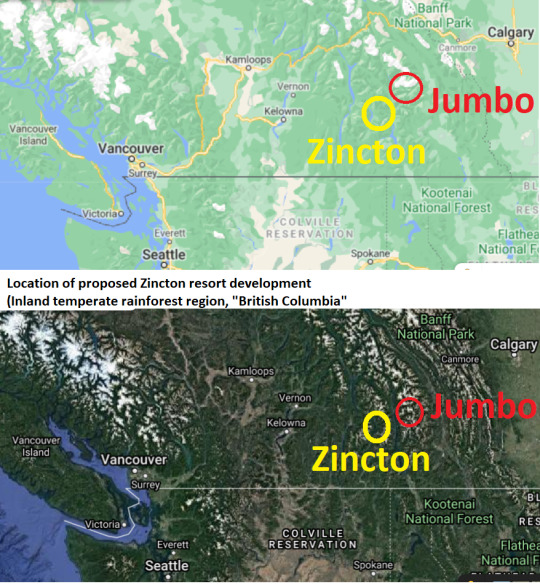
Traditional territories:
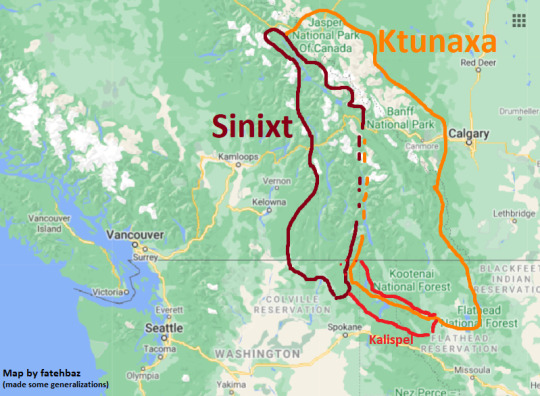
And yes, there are some updates on Zincton from November 2020.
@moss-effect -- I know that you already know this stuff. But for anyone unfamiliar:
The Zincton resort is being constructed only about 70-ish kilometers or so away from where the Jumbo resort was planned. Zincton is also on Ktunaxa territory, as well as traditional land of the Sinixt. Zincton (being built near Valhalla and Goat Range, between Naksup and Kaslo) expects a “grand opening” in December 2021. The project is run by the owner/founder of a local outfitter/recreation company. As of November 2020, BC’s Mountain Resorts Branch is still reviewing the owner’s formal proposal. Zincton sits closer to even more extensive old-growth forest and major protected areas.
Zincton also seems to be a manifestation of that now-classic category: “progressive” settler-colonial entrepreneurs from coastal BC, the Pacific Northwest, and/or Rocky Mountain West are familiar with local rhetoric and therefore elude criticism by rebranding their extractive and development projects as “eco-friendly”. According to The Narwhal (November 2020) the owner/project leader had this to say about the project: “There is a real story here of a proven disruptor facing down the mob to do one last project for the kids and grandkids. … Jobs for locals, a future for families, saving the hospital. Zincton is the Tesla of the ski village business.”
-------
Also, for context: Here’s a post I made about the inland temperate rainforest, its ecology/geography, and its endemic creatures. Here’s a post from June 2020 about the Zincton resort development. Here’s a compilation post with news/timeline/summary and maps describing the extinction of southern mountain caribou in 2019 (southern mountain caribou are a local icon, completely endemic to this region, and are highly endangered; caribou were declared extinct in the contiguous United States in 2019 when the last of the southern mountain caribou were relocated farther north to BC). Here’s a compilation post with news/timeline following the Sinixt case to receive formal recognition from BC/Canada in 2019 and 2020 (much of the rainforest, including the Zincton site, is within Sinixt traditional territory; the Canadian government declared the Sinixt “extinct” in the 1950s).
-------
Location of core cedar-hemlock forest of inland temperate rainforest region, compared with distribution range of the southern mountain caribou:
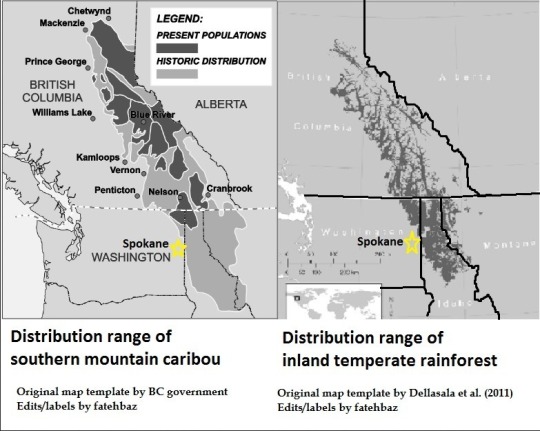
Photos I took of stream habitat in inland temperate rainforest:
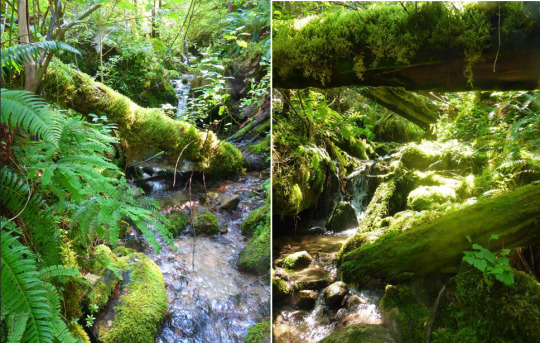
-------
Coincidentally, just a couple of days ago, The Narwhal just released an “explainer” dedicated to the Zincton: Paul Fischer. “Why B.C.’s Zincton resort, the proposed ‘Tesla of ski villages,’ is worrying conservationists.” The Narwhal. 27 November 2020.
Zincton claims that it is a “radical departure from the status quo” and will be a “carbon-zero” resort. But local groups oppose the project, including Wildsight, West Kootenay Eco Society, and locally-famous Valhalla Wilderness Society. (The core of the inland temperate rainforest is sometimes referred to as “Valhalla” or “Caribou Rainforest”.) The project also claims that the resort’s focus on so-called “eco-tourism” is a good way to “grow and replace economic decline,” which you might perceive to be a settler-colonial interpretation of the “value” of the forest and also suggests that the concern here is, of course, making money. From Fischer’s article: ‘In a series of emails with The Narwhal, Harley [the project leader] dismissed environmental concerns. He said impacted grizzly habitats are low quality and categorized the criticism from certain environmental groups as a “copy and paste” campaign motivated by a desire to oppose everything rather than contribute constructively.’
These quotes can be found in the article:







-------
Here’s some other stuff:
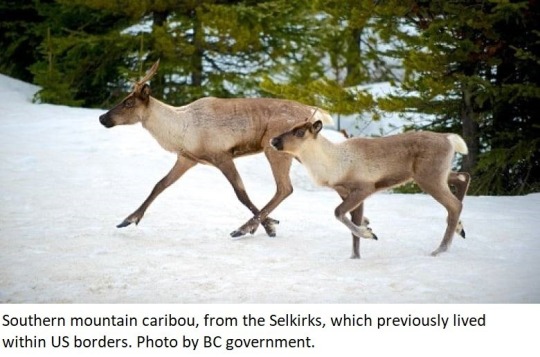
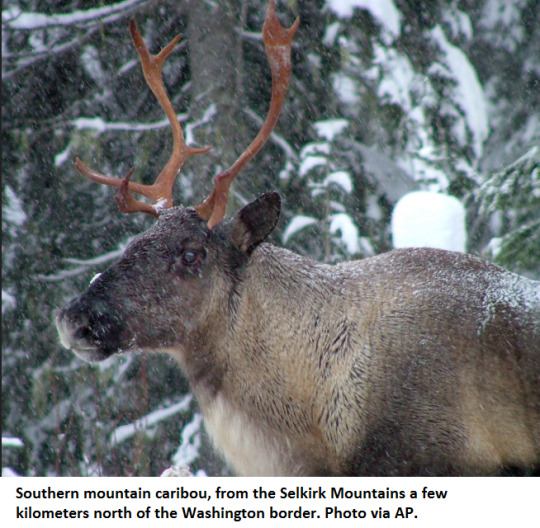
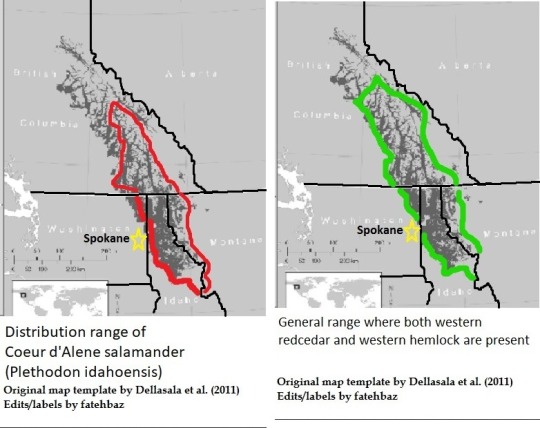
-------
Headlines from the Jumbo resort news:
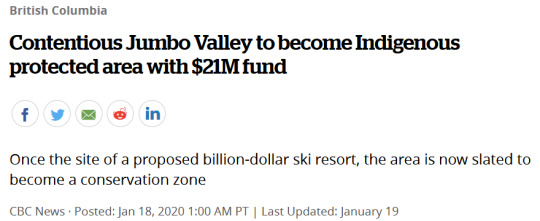
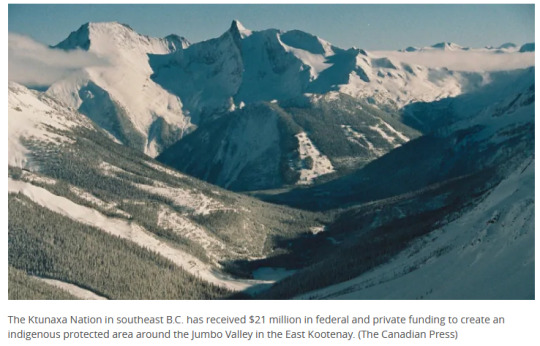
The Sinixt case:
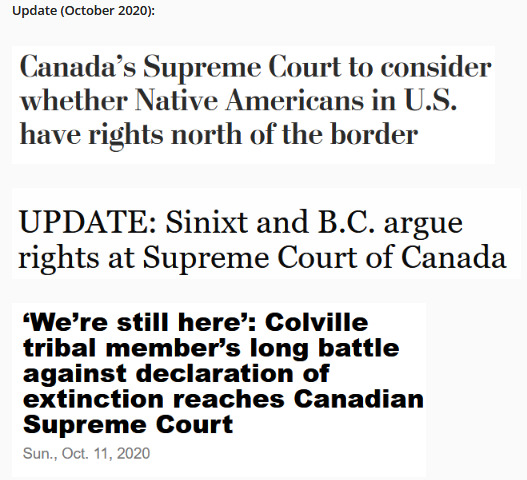
Southern mountain caribou herd decline in the inland temperate rainforest between 1990 and 2018. The Zincton resort will directly affect Purcells South, Central Selkirks, and South Selkirks herd.
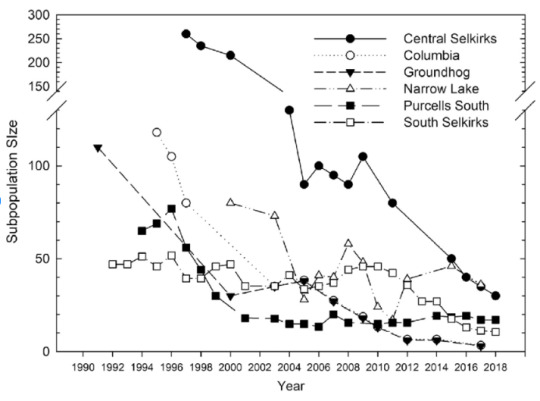

-------
And I want to say that both the Ktunaxa and Sinixt people have recently been undermined, insulted, and dispossessed by BC and development projects in similar ways. Media, educational material, and conservation groups in BC like to point out that the inland temperate rainforest is “globally-unique” (in that it’s really the planet’s only sizable “coastal-type temperate rainforest” existing inland and away from a coast). And you’ll see the inland temperate rainforest described with terms like: prized, treasure, gem, hidden/secret rainforest, etc. And the region is discussed in settler-colonial terms/concepts (”BC’s forgotten rainforest,” “BC’s other rainforest”, “a magnificent carbon cache”, “unparalleled resource”) as if it is the patrimony of the province of BC or Canadian state. Which of course is problematic because it (1) associates the forest’s importance with bioprospecting/scientific extractivism, carbon sequestration, or other metrics of settler-colonial “value,” and also because (2) the province of BC continues to fight very hard against recognizing the land as part of Sinixt territory (after Sinixt people and allies were able to win cases against BC, the province continued to appeal, and this case has now culminated in the October 2020 hearing at the federal Supreme Court, which will soon make a final ruling on whether or not Sinixt people are legally allowed land rights to harvest, travel, etc. within BC).
-------
Here’s a map:
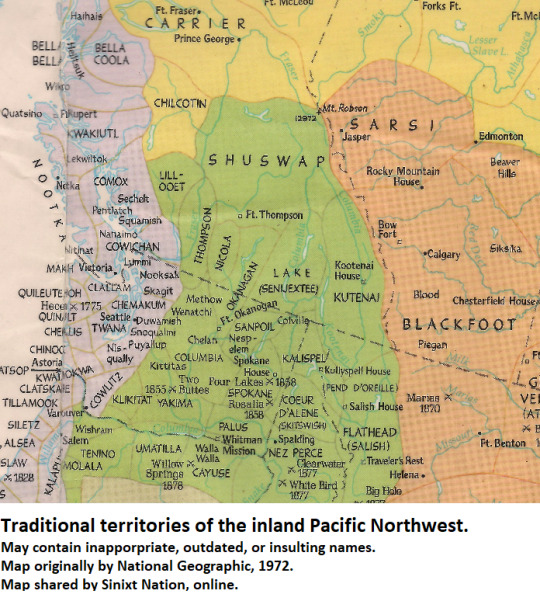
From 2018, there is this book:

In the US, too, parks, like ski resorts, are implicated in Indigenous dispossession.
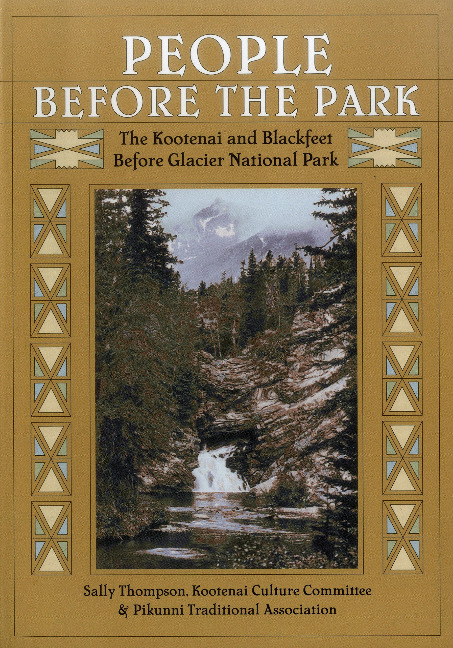
Glacier National Park (at the border of BC, Alberta, and Montana) sits on the edge of the Kootenay and inland temperate rainforest regions. Conservation groups, universities, and other US institutions have taken to calling Glacier part of “the Crown of the Continent” (another possessive/patrimonial term maybe?), a portion of the heavily-glaciated Canadian Rockies that kinda includes Banff and Jasper, too. Glacier National Park is on Ktunaxa and Blackfeet territory. A recently published book that might be interesting: People Before the Park: The Kootenai and Blackfeet Before Glacier National Park. Sally Thompson, Kootenai Cultural Committee, and Piikuni Traditional Association. 2015
Described by Montana Public Radio in 2017: “Step [...] into the world of the Kootenai and Blackfeet peoples, whose traditional territories included the area that is now Glacier National Park. [...] In this book, the Kootenai and Blackfeet tribes share their traditions -- stories and legends, foodways and hunting techniques, games and spiritual beliefs.”
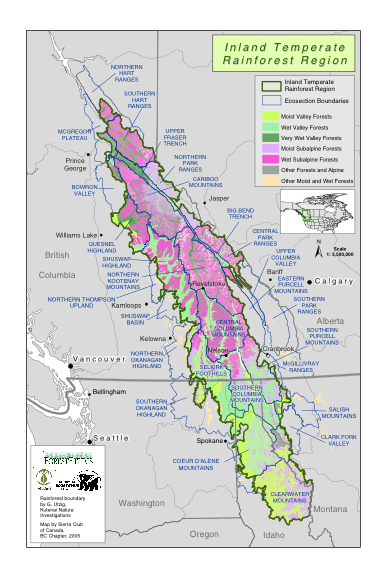
Just a special place.
Thank you for saying something.
292 notes
·
View notes
Text
Evening of the Empires Worldbuilding - Excerpts from "Wonders of Uria" by Levari Karrius
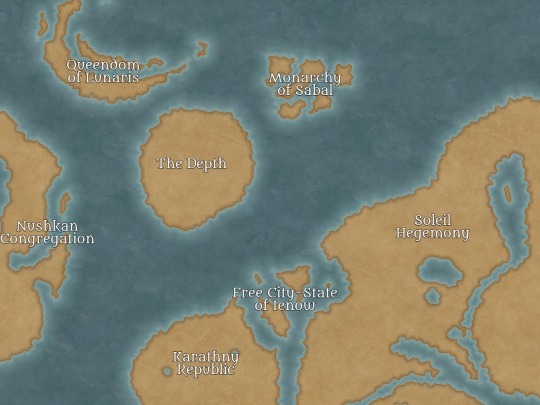
Some claim that Uria is broken; that, shortly after its creation, it was torn to pieces as an act of rage by the Lunar Mother. She swallowed most of the lands and left only scrumbles to the mortal beings. All of them have descended from The Depth, the heart of all creation, born out of Alania’s endless burning love. Scattered among what was left, the countries we know today started forming.
“But those are simply telltales,” you, my dear reader, might claim - and for a good reason. I do specialize in fantastic stories after all, but this time I shall make an exception and reach towards the truth.
And the truth is - despite all the work put into research by various scholars of all origins, we do not know much of our beginnings.
[…]
Previously mentioned Depths are mostly inhabited by dwarves, whose society flourishes despite not having a strong head of the state. They live in numerous cities, each carved in a mountain and one more impressive than another. Many among them work in mines, supplying their trade partners with either the materials or already made equipment - some dwarven merchants proudly claim that their steel is unbreakable.
Since the Depths are commonly assumed to lay above the heart of the world, many dwarves choose the path of knowledge, seeking to learn about the creation of Uria. Their expeditions go far down, to places that would never see the sunlight if it was not for these curious individuals. Most of their discoveries have shaken the very foundations of what we call science - minerals and plants never seen before or ancient underground settlements among those wonders. Gremmal Thernik, the curator of the House of the Forgotten, believes that only the surface has been scratched of what lies beneath.
[…]
Nushkan Congregation gathers numerous smaller countries, led by Nushka, a coastal kingdom ruled by the orcish dynasty of the Unbroken. However, many different races may be found among the Nushkan citizens - including humans, halflings, tieflings, and even a big population of elves. Each state governs itself, but they unite when it comes to foreign politics. The current high king, Xugash V, granted all of his vassals more power than his predecessors ever, all in return for their help in strengthening the army. This fragmentation of power may seem foolish at first glance, but it was a necessary move after a series of revolts in the region.
In the past decade, this western backwater of a country truly grew into an enemy to behold. The Unbroken Dynasty strongly focused on technological advancement, turning away from the ineffective agriculture. The harsh climate no longer stops the economy. Future Units, formed from scholars, mages and generals of all local races, became pioneers in engineering, mixing ages old magics with whole new inventions. Though, these wonders are granted to only the ones that can afford them.
[...]
Karathny Republic, built on remnants of the Ruby Empire, is a place of grand traditions. It is home to some of Uria’s greatest leaders and warriors, a place where many glorious battles occured - and, with all those legends, it should be no surprise that storytellers thrive in such an environment. The art of rhetorics is considered the most noble, which is one of the reasons for local politics being so interesting. The power here is fluid, and the people of the republic choose their representatives every five years.
The culture has always been the most important factor in this hot, deserted region with little to no natural resources. The trade routes are full with caravans transporting breathtaking paintings and sculptures or delicate, hand-woven fabrics. Along with the merchants travel various artistic troupes, lone bards and circuses. Although mostly inhabited by humans, elves and half elves native to this land, other races are seen as well - there are even a few purely orc and tiefling settlements.
[…]
The Free City-State of Ienow can be simply described as a curiosity unlike any other in the world - not only it is a melting pot of all races and cultures of Uria, it is also the smallest country that survived without being ingrained with one of the powers in the region. And the strangeness does not end at that! The politics of Ienow are dominated by the leaders of the most influential guilds in the city - Guild of Traders, Guild of Mages, Guild of Bankers, Guild of Fighters, and even… Guild of Assassins. The coastal islands are a common hideout of the pirates roaming the seas, since the system of justice is nearly non-existent. All of this makes for a rather dangerous - albeit always interesting - place to live.
Everything in Ienow revolves around two things: freedom and money. All is fair when either of those values are involved. Murders of political or economical opponents are a common practice, so are fights between gangs hired by guilds to keep the citizens in check. Those who come here seeking a new start are bound to be disappointed; it is nearly beyond possibility to climb up the social ladder. The poor immigrants are mostly employed in factories.
[...]
Queendom of Lunaris is the cradle of all things magical. This primarily elven, secluded country hosts a great entourage of mages, one more powerful than another. They are gathered in the Sorcerers’ Assembly, and the most influential members rule alongside queens from the Liaquen dynasty. Enchanters and alchemists are the backbone of the country’s economy, providing it with stable income - although the Guild of Mages offers arcane goods as well, it cannot compete with the lunarian quality.
The warm, forested islands are clearly prosperous under the reign of queen Cithren and Grand Sorceress Amarille, and one can see it even through the lense of everyday life. The roads crossing the islands are well maintained and protected, the villages and cities are all truly a sight for sore eyes, and even peasants are hospitable and content people. The only scar on Lunaris’ image is a faction led by a human preacher who calls himself Doom. Those people believe magic to be heresy, and claim that its users will bring doom upon Uria.
[…]
Soleil Hegemony thrives off conquests. What started off as a small northern county is now the grandest of the empires, and it is aiming to eventually be the only one. It was not always this ambitious, though - until recently, its sleazy aristocracy was content being stuck in the previous era, profiting off of peasants’ hard work on the fertile fields. These very devout people put their faith in the kings, believing them to be beloved sons sent by Watchful, the chief of their pantheon. No one dared to rebel against them, until recently.
After a foul murder of king Degarmo IX by a Ienowan assassin, another prominent figure rose to power - that is, General Chastain, a well respected leader of the soleilan army. Once he announced himself a dictator, everyone knew what his next step would be. He started a relentless war with what used to be the Gornorth Kingdom, and then quickly conquered the Lokei Republic. The empire grows, the nobles host decadent parties in order to celebrate victory, and countless soldiers die on the battlefields. The future seems rather unsteady.
[…]
The Monarchy of Sabal is quite a good definition for the word “underestimated”. This small country of seemingly no consequence has been around for too little time to build itself a decent reputation - it was only in the last era when a secessionist group of lunarian citizens, mostly tieflings and half elves, managed to tear them away from the Queendom. The newborn monarchy with still destabilized power attracted (and still attracts) numerous criminals, being a good alternative for the already crowded City-State of Ienow. Others have seen it as a great place for a fresh start and chose occupations of fishmongers and sailors.
The current monarch, Zarramine the Witful, truly lives up to their name. Rumor has it that the web of sabalan spies reaches far beyond the islands, all thanks to the monarch’s quite… liberal approach to outlaws. Many of them are forgiven in the local law’s eyes if they agree to work for the crown. Besides gathering information and manipulating the events from the shadows, Sabal has been building up its navy for quite some time. They would make a good operational base for soleilans if they wished to attack north and west - and many believe that soon General Chastain will turn his focus there...
45 notes
·
View notes
Text
Mixing North America with Old World Cultures in Fantasy: What Are The Issues?
So I sent in an ask several years ago that, due in no small part to your response, I have grown from and eventually led to a complete restructuring of my story. I included a measure of context in this, so if you need to skip it, my main three questions are at the bottom. I think this mostly applies to Mod Lesya.
The new setting is both inspired by and based on North America in the late 1400s where the indigenous cultures thrive and are major powers on the continent. Since there is no “Europe” in this setting the colonization and plague events never happened. Within the continent itself (since it is a fantasy setting) there are also analogous cultures that resemble Norse, Central European, Persian, Arabic, Indian, and Bengali. Although not native to the fantasy continent, there is also a high population of ‘African’ and ‘Oceanic’ peoples of many cultures, the latter usually limited to coastal cities as traders and sailors. Elves are entirely not-human, or at least evolved parallel to humans ala Neanderthals/Denisovans; they have green blood, black sclera, and skin tones that run from pale to dark.
The main national setting of the story takes great inspiration from a Byzantine/Turkish/Mississippian background, and the neighboring nations are based on the Haudenosee (Iriquois Confederacy), Numunuu (Comancheria), and the Hopi and Zuni (as the descendants of the Ancestral Puebloans) (I also know that 2 of these 3 occur much later than the 1400s, but I love the government systems and they provide excellent narrative foils for the more ‘traditional’ fantasy government that takes place in the story). The Maya inhabit the role analogous to Ancient Greece in that most writing systems on the continent descend from Maya script and all the Great Philosophers were Maya (and nobility from across the continent spend lots of money to send their children to schools in the Maya City-States or in the Triple Alliance (Aztec Empire)). There is magic with varying traditions, practices, and methods spread across the continent, some of which are kept secret from outsiders, so I would hope that this avoids the “Magical Native” trope.
Beyond the setting, I have three main questions:
When it comes to foodstuffs, I was originally planning to limit myself to Pre-Columbian cuisine from the Americas (eg the Three Sisters and potatoes) but in doing my research, Navajo fry-bread seems to be a fairly integral part of the food culture and that does require flour, which originated in the Old World. Would it be better to incorporate some of the Old World stuff that has since become traditional to indigenous groups?
For place names used in the setting and writing systems would it be better to use existing languages or writing systems or ones inspired by them? EG should I make a language that is very similar to Cherokee, complete with its own syllabary, or should I use IRL Cherokee and its extant syllabary? I ask because I feel like using the real language might step on some toes, but using the conlang might seem like erasure.
One of the main themes of this story is the harm that even a ‘benevolent’ Empire can wreak on people. The Byzantine/Turkish/Mississippian culture is the main Empire on the continent, taking cues from both western and American monarchical systems (eg the Triple Alliance (Aztec) and The Four Regions (the Inca Empire)), but when I think about it having any kind of even vaguely western ‘Empire’ spring up from the soil of a North American inspired setting might be troubling.
Thank you for your time and consideration! Do you guys have a kofi or something so I can compensate you for time spent?
I actually do remember you, and I am going to 99% disregard your questions here because you went from glaringly obvious racism to covert racism, and none of your questions ask if your basic strings of logic for assumptions you built into the setting are okay.
Since there is some extremely flawed basic logic in here, I’m going to tackle that first.
Question 1: Why did you originally title this “Pre Colombian North American Fantasy World” when you have more old world cultures than new world cultures?
A very simple, straightforward question. The actual content of the setting is what made me retitle it.
If you want to write a North American fantasy setting… why are there so many old world cultures represented here?
Old world: - Greece (as a societal myth; see next point) - Byzantine - Turkey - Norse - Central European - Persian - Arabic - Indian - Bengali - African (which, let’s be honest, should be heavily broken up into multiple peoples) - Oceana (which, again, should be heavily broken up into multiple peoples)
New world: - Mississippian - Iroquois - Numunuu - Hopi - Zuni - Maya - Aztec - Inca (maybe? not mentioned as having their own place on the continent, but one of your questions mentions them) - Navajo (maybe? See above)
To account for respecting Africa and Oceana, I’m going to make African cultures count as 3 and Oceanic cultures count as 5, and this is a purposeful lowball.
Old World: 17 New World: 9
It’s a giant discrepancy, especially if your attempt is writing an exclusively New World fantasy. And this is bare minimum old world, considering the fact I tried to limit myself to peoples who would be more likely to interact with the heavy Mediterranean/Alexander the Great’s Empire centricity.
Question 2: Why does there have to be a Greece analogue?
I haven’t spoken about this topic at length on this blog, but Greek worship in the Western world is a very carefully crafted white supremacy based mythos that was created to prop up European “Excellence” and actually erases the reality of Greece as a peoples.
Cultural evolutionism is a theory that states the (assumed-white-European) Greeks were superior because of their philosophy, their abstract art, and their mathematics. When many of these concepts were refined in Egypt (African, aka Black), or the Arab world (aka brown), but white Europeans did not want to admit any of this so they instead painted everything as coming out of their ideas of Greece lock stock and barrel.
The theory also ignored Iroquois science, Plains and Southwestern abstract art, and generally everything about North America, because the theory was designed to move the goalposts and paint North America as something it wasn’t, just to make Europeans feel okay taking it over and “bringing it to civilization.”
This theory was still taught in force up until the 1970s, and is still a major school of anthropological thought to this day (and still taught in some universities), so it is still very much influencing the Western world.
While the theory itself is only from the 1800s, it had long-growing roots in white/ noble Europe’s attempt to prop up European “Excellence” during its multiple periods of colonization, from the Crusades, onwards. You can see it in the copious amount of art produced during the Renaissance.
Europeans ignored the sheer amount of settling and travel that happened within Greece and Rome, and you’ll notice how many Renaissance paintings depict Greek philosophers as white, teaching other white people. In reality, we have no idea what their skin tone was, and they could have taught a huge variety of different skin tones. But it was appealing to European nobility to have people like them be the founders of all things great and “advanced”, so they invested huge amounts of time and money in creating this myth.
(Note: I said their nobility, not their population. People of colour existed en masse in Europe, but the nobility has been downplaying that for an exceptionally long time)
Greece took over most of the old world. It borrowed and stole from hundreds of cultures, brought it all back, and was assigned credit for it. White Europeans didn’t want to admit that the concept of 0 came from the Arabs, the pythagorean theorem came from Egypt, etc, and since Greece won, detailed records of how they were perceived and what they stole are long lost. It’s only glaring when they took from other global powers.
Question 3: Why would you pick totally different biomes to mix in here?
Turkey and the Mississippi are very, very different places when it comes to what can grow and what sort of housing is required, which makes them on the difficult side to merge together. They relied on different methods of trade, as well (boats vs roads), and generally just don’t line up.
The fact you pick such a specific European powerhouse—the Byzantine Empire—to mix into your “not European” fantasy world is… coming back to my above point about Greek (and Roman) worship in the West. Why can’t a fantasy world set in North America be enough on its own? Why does it need Europe copycats?
Question 4: Why are you missing a variety of nomads and Plains peoples?
Nomadic plains peoples were a thing across the globe, from the Cree to the Blackfoot to the Mongols. You have hyperfocused on settled peoples (with only one nomadic group named in both new and old world), which… comes across as very odd to me, because it is, again, very European sounding. That continent was about the only one without major populations that were nomadic, and if you look at European history, nomadic peoples were very highly demonized because of the aforementioned Mongols.
Cultural evolutionism also absolutely hated nomadic peoples, which is where we get the term “savage” (hunter-gatherers, nomads) and “barbarian” (horticulturalists and pastoralists, the latter nomadic); these were “lesser cultures” that needed to settle down and be brought to “civilization” (European agriculture), and nothing good could ever come out of them.
Meanwhile, in North America, nomadic peoples took up a very large portion of landmass, produced a huge amount of culture and cultural diffusion, and mostly ignoring them while trying to create a “fantasy North America” is, well, like I said: odd.
General Discussion Points
My suggestion for you is to write a fantasy Mediterranean region. Completely serious, here.
With the kinds of dynamics you are attracted to—the empires, the continental powers, the fact you keep trying to make Europe analogues in North America—you will do a much, much more respectful job by going into a really richly researched Mediterranean fantasy world than attempting to mix Europe and North America together in ways that show European traits (settled peoples, agriculture, a single empire dominating the whole culture and being viewed as superior) as the default.
I legitimately cannot see anything in here that feels like it comes from North America, or at the very least, treats non-sensationalized peoples (aka, those outside the Maya and Mississippian region) with respect.
It falls into Maya worship, which is a very sensationalized topic and is fuelled by racist fascination, assuming no Indigenous peoples could be that smart.
It falls into settled peoples worship, which is something that has cultural evolutionism roots because under such a model only settled peoples with agriculture are “civilized.”
It falls into placing Western concepts (public schools, large cities, the ilk) as the ideal, better solution, compared to methods better suited to horticulturalists, pastoralists, and hunter-gatherers and letting those teaching methods be respected.
There is no shame in writing inside Europe
The Mediterranean region contains Indigenous peoples, contains a huge diversity of skin tones, contains empires, contains democracy/a variety of governments, and in general contains every aspect of what you’re trying to create without playing god with a continent that did not evolve the way you’re trying to make it.
A Mediterranean fantasy world would still be a departure from “fantasy world 35″ as I like to call it, because it would be different from the vaguely Germanic/ French/ Norse fantasy worlds that are Tolkien ripoffs. You can dig beyond the whitewashed historical revisions and write something that actually reflects the region, and get all the fun conflicts you want.
You don’t need to go creating a European/North American blend to “be diverse.” You can perfectly respectfully write inside Europe and have as much variety in peoples as you can write in a non-European setting. Europe is not the antithesis to diversity.
North America developed a certain way for a reason. It had the required fauna, space, resources, and climate to produce what it created. The old world developed a certain way for its own reasons, based off its own factors in the same categories.
You’re not really going to get them to blend very easily, and if you did, the fact there is such a strong European way-of-life preference (by picking places that mirror European society on the surface) makes me raise an eyebrow. It’s subtle, but very much there, and the fact you are ignorant to it shows me you still need to do more work before you go writing North American Indigenous Peoples.
Writing in Europe isn’t the problem, here. Writing a whitewashed, mythologized, everyone-not-white-is-a-caricature, ahistorical “Europe” is the problem. And you cannot fix this problem by simply painting European ways of life a different skin tone when the setting isn’t European. In fact, you’re perpetuating harm by doing that, because you are recreating the cultural evolutionism that calls anything you can find in Europe “better.” Indigenous cultures were vastly different from Europe, even if they shared similar trappings.
Let North America exist without trying to shoehorn its most famous peoples into European analogues.
~ Mod Lesya
#General#Asks#submission#worldbuilding#fantasy#europe#greece#north america#Indigenous Peoples#native american#zacharandom
996 notes
·
View notes